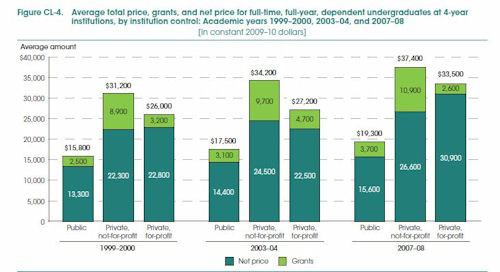Educrats are fighting back against the public frustration with rising college tuitions. And who can blame them? Once Americans get properly fed up with the bloated and insulated world of higher ed and start holding colleges and universities accountable for their price gouging, a lot of people will lose their cushy sinecures. Writing for the New York Times, Judith Scott-Clayton says the tuition increases aren’t nearly as bad as they seem.
Clayton, an assistant professor at Teachers College, Columbia University, notes in the Times’ Economix blog that while the sticker price of college has indeed increased, the average full-time student pays only half that amount, thanks to increased financial aid. “Many students,” she writes, “are actually paying less now to attend college than they would have five years ago.” (Hat tip: Larry Gross.)
That’s of comfort, I’m sure, to those who are poor enough to qualify for student aid, though not to the suckers who sacrificed to save up enough money to send their kids to college. The hard-working middle/upper middle class gets stuck paying not only their own kids’ tuitions but those of other parents as well. Higher ed has transformed itself into yet another mechanism for the redistribution of wealth in American society.
But the fact is, the cost of college continues to increase even after adjusting for grants in aid. This chart comes from the newly published The Condition of Education 2011 from the National Center for Educational Statistics.
 (Click on chart to see more legible image.)
(Click on chart to see more legible image.)
The chart shows total prices for three categories of higher ed: public institutions, not-for-profit private institutions and for-profit private institutions. Then it deducts for scholarship grants (in light green), leaving the actual price paid (in blue-green). The increase (in inflation-adjusted dollars) between 1999 and 2008 was dramatic for all three categories.
Class dismissed, Miss Clayton.



